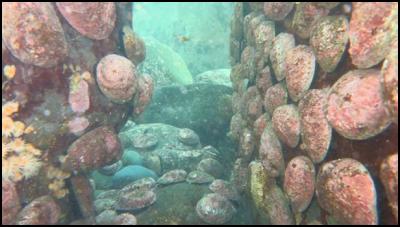Research on paua and marine reserves making waves
MEDIA RELEASE
18 October 2013
Research on paua and marine reserves making waves

Paua at Kapiti Marine Reserve. Photo: Alix Laferriere.
The impact marine reserves are having on New Zealand’s paua fishery will be clearer as a result of PhD research by Victoria University student Alix Laferriere.
Just one year into her PhD study, Alix’s research is already promising to inform sustainable management of New Zealand’s black foot paua (Haliotis iris) populations, with a focus on the role habitats play in population stability and growth.
Her study is focused on five marine reserves in the Wellington, Marlborough and Nelson regions: Kapiti Island, Taputeranga, Tonga Island, Long Island–Kokomohua and Horoirangi.
The work involves scuba diving extensively at each reserve to conduct detailed habitat assessment surveys, and counting and measuring the paua. The data gathered will allow Alix to compare how paua are faring both within and outside marine reserve boundaries.
“Previous surveys of paua and other fish species found within marine reserves have focused mainly on gathering information about the abundance and size of populations.
“However, by combining a population survey and habitat suitability analysis, I hope to identify the factors that provide optimal conditions for paua, as well as examples of particularly successful paua populations.”
Ms Laferriere says many factors are important when analysing paua habitats, from whether the area is rocky or sandy, to the abundance of seaweed (an important nutrition source) and environmental factors, such as exposure to wind and waves.
As part of her study, she has been working alongside organisations including the University of Waikato, NIWA, Davidson Environmental, the Department of Conservation, iwi, and the Paua Industry Council, as well as commercial fishermen.
The value of Alix’s research is already being recognised. In June, she received the 2013 New Zealand Marine Sciences Society student research grant, awarded to one New Zealand-based postgraduate student each year, and in August, she received a Department of Conservation award at the Society’s annual conference for the best research paper for advancing marine conservation.
Professor Jonathan Gardner from Victoria’s School of Biological Sciences, who supervises Alix, says the research will make a valuable contribution towards national conservation and management plans for the paua fishery.
“Paua, or abalone, is culturally, socially and economically important to New Zealanders—and to many other cultures around the world.
“As well as contributing towards successful management of paua, it will provide important insights as to how New Zealand’s 34 marine reserves are working.”
Alix, who has a Master’s in Marine Biology, originally trained as an Oceanographer and spent several years working for the Sea Education Association, a sail training and oceanography programme for university students.
She was inspired to move to New Zealand from the United States to undertake a PhD in Marine Reserve Science while working for the State of Oregon’s Department of Fish and Wildlife, where abalone populations have been depleted to the extent that the maximum take is four per person, per year.
“Completing my PhD in New Zealand is a great opportunity to examine a healthy abalone population’s response to marine reserve implementation,” says Alix.
ENDS


 Science Media Centre: Carbon-storing Construction Materials – Expert Reaction
Science Media Centre: Carbon-storing Construction Materials – Expert Reaction Vegetables New Zealand: New Web-Based Tool Will Help Greenhouse Growers Switch To Geothermal Heating
Vegetables New Zealand: New Web-Based Tool Will Help Greenhouse Growers Switch To Geothermal Heating Horizon Research Limited: New Poll - New Zealanders Prefer Rail Enabled Ferries
Horizon Research Limited: New Poll - New Zealanders Prefer Rail Enabled Ferries Watercare: Watercare Gets To Work On First Permanent Non-Potable Water Tanker Filling Station In Māngere
Watercare: Watercare Gets To Work On First Permanent Non-Potable Water Tanker Filling Station In Māngere Alcohol Healthwatch: Licensing Decision Lauded For Prohibiting Buy Now Pay Later Schemes In Bottle Stores
Alcohol Healthwatch: Licensing Decision Lauded For Prohibiting Buy Now Pay Later Schemes In Bottle Stores Motor Industry Association: Vehicle Registrations Up 5.6% In December, But Year-To-Date Sales Reflect Market Challenges
Motor Industry Association: Vehicle Registrations Up 5.6% In December, But Year-To-Date Sales Reflect Market Challenges



